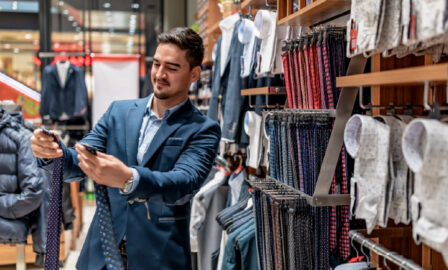Investing in Retail Technology is Investing in Your People
Retail technology is not only an investment for your technologies, it’s an investment for your company’s people. Now more than ever there is public scrutiny on working conditions for front-level employees in various industries, none more so than retail. Prior to COVID-19 there was growing support for increasing the minimum wage; with the onset of the pandemic, topics such as hazard pay and paid sick leave have also become mainstream. Often these types of benefits are seen simply as costs to be minimized, but more retailers now understand that investing in employees’ well-being and job satisfaction can drive profitability in the long term. The question for these retailers then becomes, “what is the creative solution to improve our employees’ experience in a sustainable manner?”
In fact, technology can be an enabling factor to create these win-win scenarios. Through various technology investments, retailers can improve operational excellence, empower their store managers, and expand the role of brick-and-mortar retail—all in ways that positively impact the employee experience. In this way, technology can be the cornerstone of a retail organization’s strategy to improve its people practices.
Omnichannel Retail Technology
A fundamental way in which retailers can improve employee experience through technology is by investing in omnichannel capabilities. Of course, the importance of omnichannel is not groundbreaking to any retailer, but some may not recognize the role that it plays on the labor side. Enabling omnichannel through a distributed order management (DOM) system can actually allow retailers to improve staffing at stores. Common grievances of retail employees are under-staffing, inconsistent scheduling, and inability to work enough hours to enjoy a stable and sustainable income. This results from retailers trying to match forecasted demand (projected foot traffic at the store) and minimize labor cost.
Omnichannel offers an elegant solution. With the right technology in place, a retailer can enable capabilities such as buy online pick-up in store/at curbside (BOPIS/BOPAC), as well as fulfill online orders through store inventory. Both of these capabilities expand the role of the retail employee.
We saw this trend amplified throughout the COVID-19 pandemic as retailers expanded curbside pickup and e-commerce operations. Target, for example, experienced more than 100% growth in e-commerce sales, 80% of which were fulfilled through its vast store network. As a result, Target offered additional hours to its existing employees and has increased hiring.
This improves retail jobs in multiple ways. If there is a decrease in foot traffic at the store, there is no need to shorten shifts and send employees home; instead, employees can shift their tasks to fulfilling online orders. Similarly, there is no need to schedule short working shifts and change schedules at a moment’s notice to try to perfectly meet demand. Instead, retailers are able to schedule longer, more consistent shifts—and balance employees’ focus on either in-store customer engagement or omni-order fulfillment as needed. Lastly, with longer, more predictable shifts, more of the workforce can be full time—allowing people to truly build careers within the organization.
Merchandising Systems
Another way to improve retail jobs with technology is through a best-in-class merchandising system. A common question in retail merchandising is whether to centralize or decentralize. Typically, the best answer is both, which can be made possible with a modernized merchandising system—and which can enhance the employee experience in turn.
The key is to firm up the centralized merchandise planning function with a system that is holistic—capturing the full scope of a retailer’s channels and geographies; is automated—allowing for frequent re-forecasting and nimble scenario planning; and most importantly is trusted by the organization for having strong data integrity. With forecasts and allocations that are accurate and trusted, there is now an opportunity to incorporate decentralized planning to capture regional nuances.
When the high-level plans are solid, they can be married with individualized decision-making to produce store-level plans. As such, retailers can delegate responsibility to store managers for certain purchasing or allocation decisions—for example, localized products. Of course, the appropriate scope of decentralization will differ by retailer depending on the product assortment and location. This is exemplified in retailers such as Tesco and Trader Joe’s, who both aggregate data centrally and have centralized aspects of merchandising, but also empower store managers to make decisions specific to their own store.
Giving store managers a sense of ownership over their stores’ performance has numerous benefits. Having influence over product assortment and purchasing, store managers will be more motivated because they have more impact and responsibility for store performance. They will also feel a sense of accomplishment, leading to greater job satisfaction. This strategy will improve sales because it finds a balance between standardization and localization. It’s a perfect example of retail technology enabling win-win for people and profit.
Learning Management Systems
An additional way to empower employees and create better working experiences is through training and communication. By investing in a learning management system (LMS), retailers give employees the tools they need to excel in their jobs. With proper training, employees will understand and comply with standard operating procedures, resulting in a consistent customer experience across locations.
Additionally, when employees know what the corporate guidelines are, they can recognize when a particular customer’s inquiry or request deviates from those established rules. In those scenarios, employees will feel confident using their judgement to offer the best solution to the customer. Compare this with an employee who is “learning on the fly” and has not been through proper training. This employee might feel pressured by customer demands, either guessing on the solution or simply telling the customer they’re unable to assist. It’s clear to see how employee training would pay off in this scenario.
Home décor retailer At Home found that “stores with higher associate knowledge levels also show an increase in performance drivers such as sales and conversion. On average, these stores have 10% higher associate knowledge levels and achieve greater sales per week.” The retailer also credits their LMS for lower employee turnover because it gives employees “more confidence in their role.” It doesn’t stop with training—a retail communications platform is another part of the equation for confident, empowered employees. When employees have the information required to do their jobs, they will be more effective, efficient, and satisfied in their roles.
A pertinent case study is retail communications platform Zipline, which enables targeted store communication and task management. Beverage retailer BevMo! saw increased sales after implementing the solution, as well as positive feedback from employees— “[t]hey love knowing that their work is being recognized by management.”
Retail technology by itself will not inherently improve working conditions. But for a retailer that is looking for ways to sustainably improve its people practices, technology can be an enabler to that goal. If that is a goal for your organization, reach out to our retail experts—Clarkston can help assess technology opportunity areas to create a stronger retail organization where employees and sales thrive.



